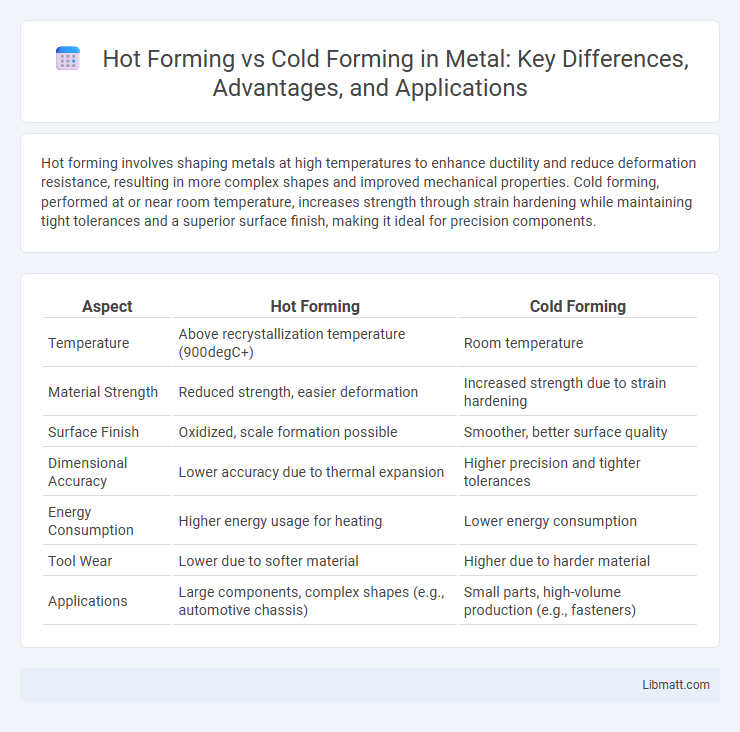Hot forming involves shaping metals at high temperatures to enhance ductility and reduce deformation resistance, resulting in more complex shapes and improved mechanical properties. Cold forming, performed at or near room temperature, increases strength through strain hardening while maintaining tight tolerances and a superior surface finish, making it ideal for precision components.
Table of Comparison
| Aspect | Hot Forming | Cold Forming |
|---|---|---|
| Temperature | Above recrystallization temperature (900degC+) | Room temperature |
| Material Strength | Reduced strength, easier deformation | Increased strength due to strain hardening |
| Surface Finish | Oxidized, scale formation possible | Smoother, better surface quality |
| Dimensional Accuracy | Lower accuracy due to thermal expansion | Higher precision and tighter tolerances |
| Energy Consumption | Higher energy usage for heating | Lower energy consumption |
| Tool Wear | Lower due to softer material | Higher due to harder material |
| Applications | Large components, complex shapes (e.g., automotive chassis) | Small parts, high-volume production (e.g., fasteners) |
Introduction to Hot Forming and Cold Forming
Hot forming involves shaping metals at elevated temperatures, typically above the recrystallization point, allowing increased ductility and reduced strength for easier deformation. Cold forming is performed at or near room temperature, enhancing material strength and surface finish through strain hardening but requiring higher force. Both processes significantly influence mechanical properties, surface quality, and production efficiency in metal fabrication.
Defining Hot Forming: Processes and Applications
Hot forming involves shaping metals at temperatures above their recrystallization point, enhancing material ductility and reducing yield strength for easier deformation. Common processes include hot rolling, forging, and extrusion, widely used in automotive, aerospace, and construction industries to produce complex shapes with improved mechanical properties. Understanding hot forming benefits your manufacturing by enabling enhanced formability and superior structural performance compared to cold forming.
Cold Forming: Techniques and Typical Uses
Cold forming processes such as cold rolling, extrusion, and stamping shape metals at or near room temperature to enhance strength and surface finish through strain hardening. Typical uses include manufacturing precision components like fasteners, automotive parts, and electrical connectors where high dimensional accuracy and superior mechanical properties are essential. These techniques reduce material wastage, improve mechanical performance, and minimize post-processing requirements compared to hot forming.
Key Differences Between Hot Forming and Cold Forming
Hot forming involves shaping metals at high temperatures above their recrystallization point, enhancing ductility and reducing strain hardening, whereas cold forming occurs below this temperature, increasing material strength through work hardening. Hot forming allows for complex geometries with reduced residual stresses but requires more energy and longer processing times compared to cold forming, which offers better surface finish and dimensional accuracy. Your choice between hot and cold forming depends on the desired mechanical properties, part complexity, and production efficiency.
Material Suitability: Choosing the Right Forming Method
Hot forming is ideal for metals with high carbon content or alloys that become brittle at room temperature, allowing you to shape complex geometries without cracking. Cold forming suits ductile materials like aluminum and low-carbon steel, enhancing strength through strain hardening while maintaining tight dimensional tolerances. Selecting the right process depends on your material's properties and the desired mechanical characteristics of the finished product.
Mechanical Properties: Strength, Ductility, and Surface Finish
Hot forming enhances material strength by refining grain structure and reducing residual stresses, resulting in superior ductility compared to cold forming. Cold forming improves surface finish and work hardens the material, increasing strength but often compromising ductility due to strain hardening. Your choice between hot and cold forming depends on balancing required mechanical properties and surface quality for the application.
Energy Consumption and Cost Comparison
Hot forming typically requires more energy due to the high temperatures needed to heat the material, leading to increased operational costs. Cold forming consumes less energy as it processes materials at or near room temperature, reducing heating expenses and allowing for faster cycle times that lower overall production costs. Your choice between hot and cold forming should consider these energy consumption differences alongside material properties and final product requirements.
Industrial Applications and Market Trends
Hot forming enables the manufacture of complex, high-strength automotive and aerospace components by enhancing material ductility during deformation. Cold forming is widely used in mass production of fasteners, pipes, and household appliances due to its cost efficiency and superior surface finish. Market trends indicate growing demand for hot forming in lightweight vehicle design, while cold forming maintains dominance in high-volume, precision metal part fabrication.
Advantages and Disadvantages of Each Process
Hot forming enhances metal ductility and reduces machining forces by heating the material above its recrystallization temperature, resulting in complex shapes with minimal residual stresses; however, it may cause oxidation, scale formation, and dimensional inaccuracies due to thermal expansion. Cold forming offers superior surface finish, increased strength from strain hardening, and tight dimensional tolerances by shaping metal below its recrystallization temperature, but it requires higher forming forces and can lead to work hardening, making subsequent processing more difficult. Understanding these trade-offs helps you select the optimal forming process suited to your manufacturing needs and material properties.
Conclusion: Selecting the Optimal Forming Technique
Selecting the optimal forming technique depends on material properties, desired mechanical strength, and production requirements. Hot forming enhances ductility and reduces residual stresses, making it ideal for complex shapes and high-strength applications, while cold forming offers superior surface finish, dimensional accuracy, and cost-efficiency for high-volume production. Evaluating factors such as thermal effects, strain hardening, and tooling costs ensures the best choice between hot and cold forming processes.
hot forming vs cold forming Infographic

 libmatt.com
libmatt.com